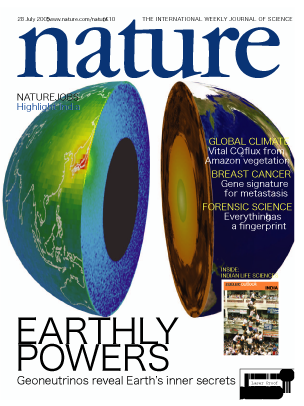
KamLAND Announcement of Results:

 |
28 July 2005
KamLAND Announcement of Results: |
 |
 |
 |
|
The KamLAND collaboration has for the first time measured the flux of neutrinos emanating from the earth due to the earth's natural radioactivity. For nearly fifty years, since neutrinos were discovered, physicists have been hoping to measure the electron anti-neutrinos that come from Uranium and Thorium decays from the whole earth. Geologists can only directly study the rocks very near the earth's surface. For greater depths they must infer the makeup of the earth from seismic measurements, which give only a velocity (and not composition) and then guess the mixture based upon meteorite contents and what is known about geochemistry under high pressures and temperatures. There has in fact been much debate over the years about the actual contents of the seismically revealed layers of crust, upper mantle, lower mantle, outer and inner core. There has also been much controversy about the heat emission of the earth. A large part of that heat flow, estimated generally at 44 TeraWatts (but maybe as low as 31 TW), is thought to be due to radioactivity in the earth, about 19TW total based upon the geologists standard Bulk Silicate Earth model. The KamLAND group finds a neutrino flux consistent with this number, about 28 +/- 15 TW, with a 90% confidence level upper limit of 60TW. While the results from KamLAND do not strongly constrain the models of earth's contents as yet, this first measurement marks a beginning of the era of being able to "see" the earth's insides with neutrinos, much as done with medical scans of humans. An upgraded KamLAND, and future detectors on land and at sea making multiple measurements, will be able to sort out the contributions from the various layers. One important aspect of this measurement is that it bears upon determining the heat budget of the earth. It is thought that a deep heat source is needed to power the plumes that (continuously) generate the earth's magnetic field (and sometimes flip it or stop it for a while). Without the earth's magnetic field, the atmosphere would be at risk and radiation would be higher on earth. Perhaps the earth would wind up as a dead planet like Mars without the magnetic field. So understanding the driving power is important to understanding life on earth (and perhaps other planets). The neutrino measurements within a few years may be able to determine the distribution of the radioactive materials in the earth, and sort out the radioactive decay contributions to the heat flow. |
Last modified: 31 July 2005
University of Hawaii / jgl@phys.hawaii.edu